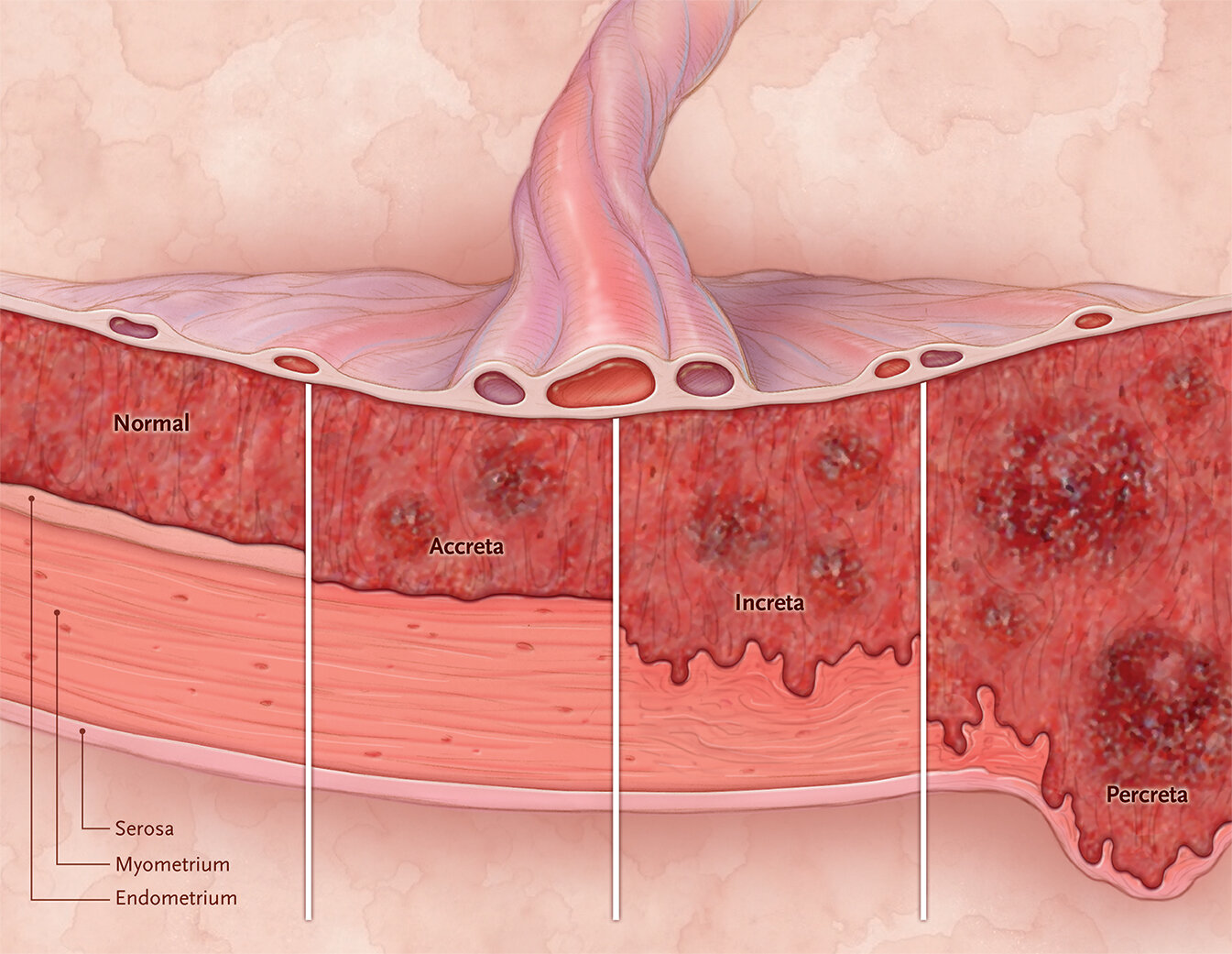Choosing The Route of Hysterectomy
/Here’s the RoshReview Question of the Week!
A 49-year-old P3003 woman presents to the clinic with a complaint of heavy menses for several years and asks for definitive management. She has a history of type 4 fibroids, all < 3 cm, and hypercholesterolemia. Her obstetrical history is significant for two vaginal deliveries and one cesarean section. On physical examination, her BMI is 31 kg/m2. Her uterus is anteverted, and the fundus reaches 3 fingerbreadths below the umbilicus. What surgical intervention would be most cost- and clinically effective for this patient?
Check if you got the right answer at the links above!
Reading: Committee Opinion 701 - Choosing the Route of Hysterectomy for Benign Disease
Why do we do a hysterectomy?
Hysts are one of the most common surgeries in the United States (per the CDC, over 600,000 are performed annually)
Many of them are elective - ie. patients are choosing surgical option over medical for example
Reasons for hysterectomy - so many! We review this in some of our other topics such as
Uterovaginal Prolapse (Episode 35) - https://creogsovercoffee.com/notes/2019/5/5/uterovaginal-prolapse
Abnormal Uterine Bleeding (Episode 47) - https://creogsovercoffee.com/notes/2019/7/28/abnormal-uterine-bleeding-the-basics
Acute Uterine Bleeding (Espresso Episode 8) - https://creogsovercoffee.com/notes/2021/7/11/espresso-acute-uterine-bleeding
Gestational Trophoblastic Disease (Episode 55) - https://creogsovercoffee.com/notes/2019/9/29/4c3svbxi5jlecxdrk1tnvoykxs1y5h
Endometrial Cancer (Episode 69) - https://creogsovercoffee.com/notes/2020/1/12/endometrial-cancer
Fibroids (Episode 81) - https://creogsovercoffee.com/notes/2020/4/12/fibroids
Cervical Cancer (Episode 101) - https://creogsovercoffee.com/notes/2020/12/6/cervical-cancer
Placenta Accreta (Episodes 113-114)
https://creogsovercoffee.com/notes/2021/3/7/placenta-accreta-part-i
https://creogsovercoffee.com/notes/2021/3/14/placenta-accreta-part-ii-management
Endometriosis (Episode 142-143)
https://creogsovercoffee.com/notes/2021/10/3/endometriosis-part-i-evaluation-and-diagnosis
https://creogsovercoffee.com/notes/2021/10/10/endometriosis-part-ii-treatment
Just to name a few… and remember, we will only discuss benign reasons
What exactly are the ways to do a hyst anyway and why does route matter?
Note: We won’t go into exact techniques here since we are a podcast. However, some great resources include the Atlas of Pelvic Surgery online: http://www.atlasofpelvicsurgery.com/home.html
Also the textbook by Baggish and Karam: Atlas of Pelvic Anatomy and Gynecologic Surgery
Vaginal hysterectomy
First type of minimally invasive hysterectomy
Advantages
Preferred type of hysterectomy when possible due to no incisions on the abdomen and minimally invasive route
High safety and low cost
Meta-analysis of seven trials report similar rates of visceral injury and long-term complication among vaginal and laparoscopic procedures
Minimally invasive approach associated with faster recovery compared to laparotomy
Disadvantages
Unfortunately, despite advantages, there are fewer vaginal hysts performed compared to others due to limited training, fewer numbers of hysts overall being performed and greater diversity of operative approaches
Must remove cervix with this type of procedure - no option for supracervical hyst
Small chance of converting to laparotomy
Laparoscopic hysterectomy
Usually performed with laparoscopic instruments via 3-4 small ports in the abdomen. Uterus can be morcellated and removed through a bag (morcellate in bag) or via the vagina
Increasing in popularity
Advantages
Better visualization with minimally invasive surgery
Can perform supracervical hyst if needed
Can also perform last part vaginally for ease if needed
May be easier in some obese patients
Disadvantages
Requires surgeon skilled in use of laparoscopy
Certain patient populations with certain medical illnesses may not tolerate Trendelenburg position or pneumoperitoneum
Possibility of conversion to laparotomy
Slightly higher rate of vaginal cuff dehiscence compared to other routes of hyst (still low, like 0.64-1.1%)
Robotic hysterectomy
Very similar overall in terms of advantages and disadvantages to laparoscopic hysterectomy due requiring Trendelenburg and pneumoperitoneum, as well as minimally invasive course
Advantages
Superior visualization compared to traditional laparoscopy due to ability to move camera and 3D vision
Mechanical improvement - wrists with robots
Better stabilization of instruments
Improved ergonomics for surgeons - you can sit down (as someone who has definitely passed out during a long case)
Even more options for minimally invasive routes (ie. single port hyst)
Disadvantages
Additional surgical training
Does not necessarily decrease time (in fact can increase cost and operating room times)
Cost of instruments overall + cost of robot
Lack of haptics (no tactile feedback)
Abdominal hysterectomy
Only non minimally-invasive technique
Advantages
Visualization
Ability to remove large masses and large uteruses
Tactile feedback
Lowest risk of vaginal cuff dehiscence compared to other methods
Studies like the VALUE study and the eVALuate trial showed decreased rates of complications of abdominal hyst compared to laparoscopic hyst, but these studies are also old (1990s)
Disadvantages
Increased postoperative pain and length of stay (average LOS is 3 days after abdominal hyst)
Increased risk of bleeding and infection
Increased risk of VTE (also may be due to increased stasis)
Increased risk of colonic stasis
How do we pick the route of hysterectomy?
Consideration of minimally invasive routes
MIS should be considered whenever possible because of well-documented advantages over abdominal hysterectomy
Vaginal hyst is preferred over other types due to cost, effectiveness, and overall outcomes
Even if opportunistic salpingectomy is desired, these can be performed with vaginal hysterectomy
Anatomy
Size and shape of vagina and uterus + descent of uterus
More difficult to perform a vaginal hysterectomy if there is no descent, if there is large uterus (bulky fibroids) and small introitus
However, nulliparity is not a contraindication to vaginal hysterectomy
Study showed that 92% of vaginal hysterectomies planned for women with no prior vaginal deliveries could be successfully completed
Accessibility of the uterus also important - is there likely to be a lot of pelvic adhesive disease? (endometriosis)
Large uterine size - morcellation has come under scrutiny previously
However, still can morcellate in a bag
Even if large, bulky uterus, can refer to skilled MIS surgeon
Need of concurrent procedures (ie. will the patient need their appendix removed as well?)
Work up:
Physical exam with evaluation of mobility of uterus on bimanual
Evaluation for adnexal masses on bimanual
Feel for fundal height
Pelvic ultrasound may be helpful
Surgeon comfort/preference
Surgeon preference for other operative routes - no longer considered an appropriate reason to avoid vaginal approach
Surgeon experience
Average case volume
Available hospital technology, devices, and support
Patient preference
If patient desires supracervical hysterectomy, will need laparoscopic or abdominal approach
However, no clinically significant difference in complication and uncertain benefit in terms of patient outcomes (ie. sexual function, urinary function, bowel function)
ACOG CO 701




